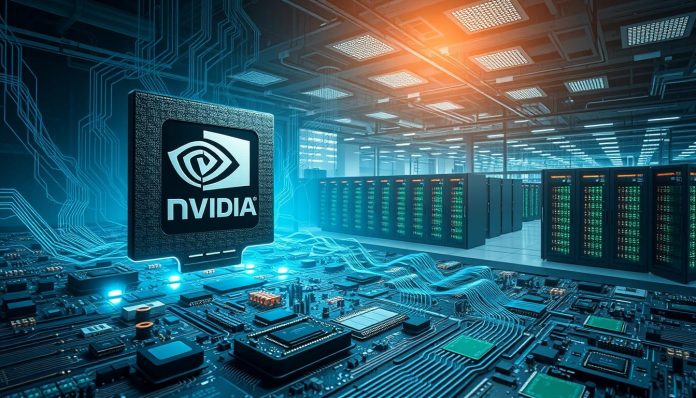NVIDIA has turned into a household name in the technological sphere and especially in artificial intelligence and graphics processing. The innovative nature of the company in its chip design has turned it into an essential aspect in the technology sector.
The monopolistic control of NVIDIA in the chip market has resulted in silent reliance on the corporation by the Big Tech companies. NVIDIA as a major chip maker has its products featured in the creation of several other state-of-art technologies.
The dependence on NVIDIA poses some crucial questions regarding the status of the company on the market and the possible threats of its domination.
Key Takeaways:
- NVIDIA is also a dominant competitor in the chip industry especially in AI and GPU.
- The use of innovative designs of chip by NVIDIA has become dependent to Big Tech.
- The hegemony of the company questions the risks and competition in the market.
- The products of NVIDIA play a significant role towards the creation of advanced technologies.
- NVIDIA reliance is one of the strong factors of the success of the tech industry.
Unparalleled Ascent to market dominance of chips at NVIDIA:
The trajectory followed by NVIDIA to become the leader in AI is a story of strategic innovation and technological development as it becomes no longer a company focused on the game but on AI. This has been brought about by a blend of changes such as its innovative work in the field of the graphics card and its capacity to keep up with the new trends in the technological world.
Gaming Graphics to AI Powerhouse:
The history of NVIDIA has its origin in the gaming graphics industry where its products have become the best way to provide high-performance GPUs to users. With time, the firm used its experience in parallel processing to venture into the area of AI where it could see how GPUs can be used to speed up sophisticated calculations that will be needed in machine learning and deep learning.
The Technology Giving NVIDIA Its Edge:
NVIDIA’s dominance in the AI chip market can be attributed to several key technologies. Two of the most significant are its CUDA software ecosystem and its cutting-edge hardware innovations.
CUDA Software Ecosystem
The CUDA platform has been instrumental in NVIDIA’s success, providing developers with a powerful tool for creating applications that leverage the parallel processing capabilities of NVIDIA GPUs. CUDA allows for the acceleration of compute-intensive tasks, making it an essential component in the development of AI and HPC applications.
- Enables developers to harness the power of NVIDIA GPUs for complex computations.
- Supports a wide range of programming languages and frameworks.
- Has become a de facto standard in the industry for GPU-accelerated computing.
Hardware Innovations:
NVIDIA’s hardware innovations have been equally crucial, with the company continually pushing the boundaries of what is possible in GPU design. The development of Tensor Cores, for example, has significantly accelerated matrix operations critical to deep learning algorithms.
The combination of advanced hardware and a robust software ecosystem has enabled NVIDIA to stay ahead of the competition, providing a platform that supports the development of increasingly sophisticated AI applications.
As a result, NVIDIA has become the go-to partner for many of the world’s leading tech companies, which rely on its GPUs to power their AI initiatives. This reliance underscores the significant role NVIDIA plays in the AI ecosystem and highlights its position as a leader in the chip market.
Big Tech’s Growing Reliance on a Single Supplier:
As the demand for AI and cloud computing continues to surge, Big Tech companies have found themselves increasingly dependent on NVIDIA. This reliance is not merely a matter of convenience but a necessity driven by the unparalleled performance of NVIDIA’s GPUs in handling complex AI workloads.
How Tech Giants Became Dependent on NVIDIA GPUs:
The journey to dependence began with the rapid expansion of cloud computing services and the growing need for powerful processors that could handle AI training tasks efficiently. NVIDIA’s GPUs, with their massively parallel processing architecture, were perfectly suited to meet this demand.
Cloud Computing and AI Training Demands:
Cloud computing has become the backbone of modern tech infrastructure, with services like Google Cloud, Amazon Web Services (AWS), and Microsoft Azure relying heavily on NVIDIA GPUs to power their AI and machine learning capabilities. The demand for these services has skyrocketed, driven by the need for faster and more efficient processing of complex AI models.
- Google Cloud: Utilizes NVIDIA GPUs to enhance its AI and machine learning services, providing customers with powerful computing resources.
- Meta: Leverages NVIDIA GPUs for AI research and development, accelerating the training of complex models.
- Microsoft Azure: Integrates NVIDIA GPUs into its cloud infrastructure, offering high-performance computing capabilities for AI and other demanding workloads.
The Financial Stakes for Companies Like Google, Meta, and Microsoft:
The financial implications of relying on NVIDIA are significant. The cost of purchasing and maintaining NVIDIA GPUs can be substantial, affecting the bottom line of these tech giants. Moreover, the dependence on a single supplier introduces risks related to supply chain disruptions and pricing volatility.

In-House Chip Development: Big Tech’s Response:
In response to their growing dependence on NVIDIA, Big Tech companies have started to invest in developing their own custom chips. This move is aimed at reducing reliance on external suppliers and gaining more control over their computing infrastructure.
Google’s TPUs and Meta’s Custom Silicon:
Google has developed its Tensor Processing Units (TPUs), designed specifically for machine learning tasks. These custom chips offer significant performance improvements for Google’s AI workloads. Similarly, Meta has been working on its custom silicon, aimed at enhancing the performance and efficiency of its AI research and applications.
- Google’s TPUs are optimized for TensorFlow, Google’s machine learning framework, providing a tightly integrated solution for AI computing.
- Meta’s custom silicon is designed to accelerate AI research, enabling the company to develop more sophisticated AI models.
The Challenges of Breaking Free from NVIDIA:
While developing custom chips is a strategic move, it comes with its own set of challenges. The development process is complex and costly, requiring significant investment in design, manufacturing, and testing. Moreover, NVIDIA’s ecosystem is deeply entrenched, making it difficult for new entrants or even existing companies to match its performance and efficiency.
The path forward for Big Tech companies involves balancing their reliance on NVIDIA with the development of their own custom solutions. As the demand for AI and cloud computing continues to grow, the stakes will only get higher, making it crucial for these companies to navigate their dependence on NVIDIA carefully.
Conclusion: The Future of the AI Chip Landscape:
The AI chip market is at a pivotal moment, with NVIDIA at its center. Big Tech companies have become increasingly reliant on NVIDIA’s GPUs to power their AI initiatives. As the demand for AI capabilities continues to grow, the chip market is expected to evolve.
NVIDIA’s dominance is likely to be challenged by Big Tech’s in-house chip development efforts. Companies like Google, Amazon, and Microsoft are investing heavily in custom chip technology, potentially reducing their dependence on NVIDIA.
The future of the AI chip landscape will be shaped by the interplay between NVIDIA’s continued innovation and Big Tech’s custom chip development. As the market continues to evolve, it will be interesting to see how NVIDIA adapts to the changing landscape and whether Big Tech companies can successfully develop their own AI chips.
The ongoing developments in the AI chip market will have significant implications for the tech industry as a whole. As AI becomes increasingly integral to various applications, the demand for specialized chips will continue to drive innovation and growth in the chip market.
FAQ:
What is NVIDIA’s role in the chip market?
NVIDIA is a leading chipmaker that has become a crucial component in the tech industry, particularly in AI and GPU technology.
How did NVIDIA become a leader in the chip market?
NVIDIA transitioned from being a gaming graphics company to an AI powerhouse, leveraging its CUDA software ecosystem and hardware innovations to gain a competitive edge.
Why are Big Tech companies dependent on NVIDIA GPUs?
Big Tech companies like Google, Meta, and Microsoft rely on NVIDIA GPUs to meet the demands for cloud computing and AI training, which has significant financial implications for these companies.
Are Big Tech companies developing their own custom chips?
Yes, companies like Google and Meta are developing their own custom chips, such as Google’s TPUs and Meta’s custom silicon, in an effort to reduce their dependence on NVIDIA.
What are the challenges of breaking free from NVIDIA’s dominance?
Developing custom chips is a complex task, and companies face significant challenges in breaking free from NVIDIA’s dominance, including the need to develop compatible software ecosystems.
What is the future of the AI chip landscape?
The future of the AI chip landscape is likely to be shaped by ongoing developments in custom chip technology, potentially leading to shifts in the market and changes in the balance of power between chipmakers like NVIDIA and Big Tech companies.
How does NVIDIA’s CUDA software ecosystem contribute to its success?
NVIDIA’s CUDA software ecosystem provides a comprehensive platform for developers to build AI and HPC applications, making it a key factor in NVIDIA’s success and a barrier to entry for competitors.
What are the implications of Big Tech’s reliance on NVIDIA for the tech industry?
Big Tech’s reliance on NVIDIA has significant implications for the tech industry, including the potential for NVIDIA to exert significant influence over the direction of the industry and the development of new technologies.


